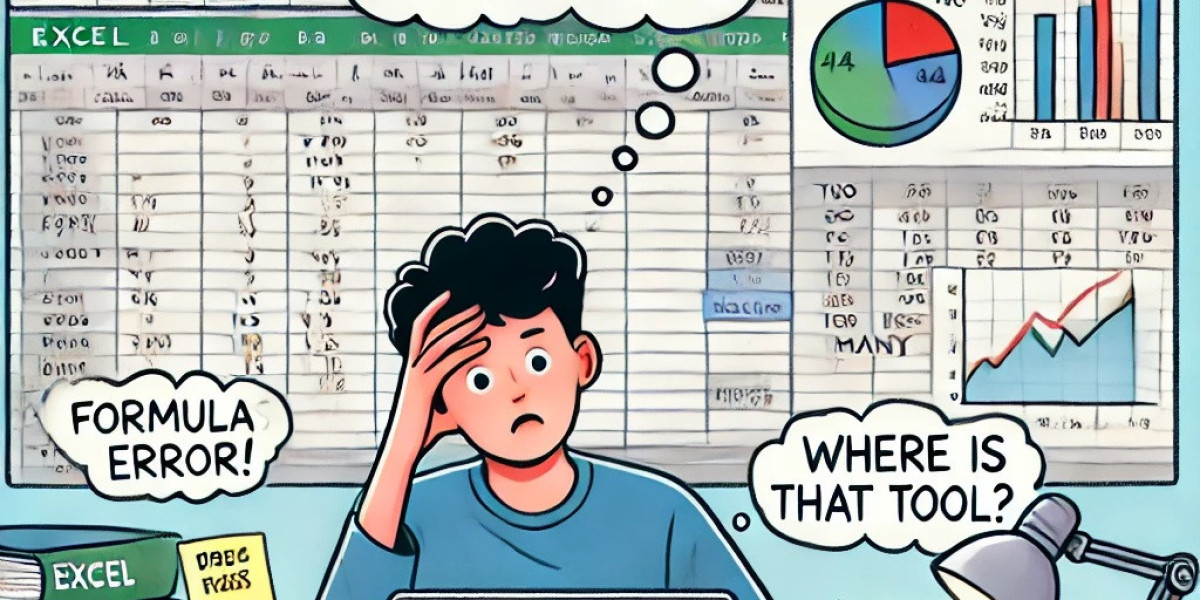If you’re new to Excel, the whole thing can feel like stepping into a maze with no map. Seriously, you open the app, and there’s a blank grid staring back at you like it’s daring you to figure it out. All those rows, columns, and the zillion functions just sitting there, ready to confuse you. It's no wonder that for a lot of students, Excel feels like some kind of high-level magic trick. But here’s the deal: while it might feel complicated at first, with a little patience, it’s not as wild as it seems. Let’s break down why Excel feels like a beast to tackle, and how you can get past that feeling.
1. The Grid Makes No Sense at First
Okay, so the first thing most students will notice is the grid. Rows, columns, and cells. Sounds simple enough, right? Except it’s kinda not. It’s like when you walk into a huge room full of books, but you have no idea where to start looking. Every number and letter combination on the columns and rows makes you think, “What am I even looking at here?” The grid just feels overwhelming. There’s nothing intuitive about it. You’re supposed to know where to click, what to drag, and how to enter data, but without any guidance, you end up just staring at a bunch of random letters and numbers. And honestly? It can feel frustrating.
But here’s the thing: once you start understanding how the rows and columns work together to create a structure, it’s easier to organize your data. It's not a beast – it's a system, just one that requires you to learn its rules.
2. The Functions: There Are So Many!
Now, let’s talk functions. When you’re just starting out, it’s easy to feel like you’re trying to juggle flaming swords. You hear terms like VLOOKUP, SUMIF, and INDEX/MATCH, and your mind just shuts down. You're like, "Can’t I just type in the numbers and be done?" The truth is, Excel has a ton of functions, but that’s not a bad thing. Functions are what make Excel so powerful! They let you do everything from simple addition to complex data analysis. But again, at first, it’s like walking into an all-you-can-eat buffet and not knowing where to start.
For students who are just starting with Excel, it can feel like you’ve got to memorize a whole dictionary of formulas. But, as you keep using it, you'll realize that most of them follow a pattern or logic. Once you get the hang of a few basic ones, things start to click. The first time you use SUM or AVERAGE to quickly calculate totals, you might feel like a genius. And that feeling? It’s awesome. Trust me, once you start adding in a few functions, you’ll wonder why you didn’t learn them sooner.
3. The Fear of Making Mistakes
For a lot of students, one of the most stressful things about learning Excel is the fear of making mistakes. This is probably one of the biggest roadblocks for beginners. You’re trying to get things right, and every time you mess up, it feels like the whole thing will collapse. But here's the thing: making mistakes is how you learn. And in Excel, it’s a whole lot harder to “break” the program than it feels. If you mess up a formula or type something in the wrong cell, it’s usually easy to fix. You can undo changes (thank you, Ctrl + Z!), or you can quickly correct the issue.
This fear of making mistakes can sometimes paralyze you from even trying. But once you give yourself permission to make those mistakes, you'll find that it becomes way easier to keep going. And trust me, everyone’s made those weird mistakes. It’s just part of the process. The key is to practice, and practice often.
4. Excel Has Its Own Language
If you’ve ever tried to Google a question about Excel, you know it’s like trying to decipher a secret code. People talk in formulas, jargon, and shortcuts that sound more like a secret society’s language than something normal people can understand. Terms like “absolute reference” and “pivot table” might sound like gibberish, and that’s totally okay. For someone new to Excel, it’s like trying to learn a new language, and it doesn’t come naturally at first.
But, as with anything, once you get familiar with the lingo, things start to make sense. You don’t need to know every term from the get-go, but understanding a few key terms will go a long way in making you feel less lost. Over time, you'll get more comfortable with the language of Excel, and what once seemed like nonsense will start to feel familiar.
5. The Toolbars and Options Are Overwhelming
When you first open Excel, you’re met with a sea of buttons. There’s the Ribbon with options you’ve never seen before, and toolbars you didn’t even know you needed. For a beginner, it can be hard to know where to click or which options to use. It's not just the functions themselves that are confusing – it’s the whole environment around them. You might be thinking, "Why are there so many buttons for something as simple as making a chart?" The truth is, Excel is packed with tools that help users do everything from simple calculations to complex statistical analysis. But, if you’re just getting started, it’s easy to feel lost in the ocean of choices.
One trick is to keep things simple at first. Don’t try to learn everything at once. Start by focusing on just a few tools that help you with your specific project. As you get more comfortable, you’ll start experimenting with the more advanced tools. Think of it like trying to learn a new sport – you don’t jump straight into the pro league. You start with the basics, and as you build your skills, you can move up.
6. Dealing with Large Amounts of Data
Excel is built for handling large datasets, but for beginners, this can be a double-edged sword. When you're dealing with hundreds or thousands of rows of data, it’s easy to feel like you’re drowning. Sorting, filtering, and even navigating can become a pain. Plus, trying to spot errors in large datasets is a nightmare. If you’re looking at a big table with numbers, formulas, and different formats, it can feel like your eyes are playing tricks on you.
The good news? There are tons of ways to organize and manage large amounts of data in Excel. You can use sorting and filtering tools to break things down into manageable chunks. You can even create a Pivot Table to summarize huge datasets in a few clicks. And though these things may seem intimidating, once you get the hang of them, they’ll feel like your best friend.
7. Excel isn’t something you master overnight
Excel isn’t something you master overnight. According to the Excel Homework Helpers the key to getting comfortable with Excel is understanding that it’s a gradual process. No one expects you to be an Excel pro right away. The best way to get better is to break it down into smaller steps. Start with the basics, practice regularly, and don’t be afraid to ask for help when you need it. Most of the complicated stuff won’t seem so complicated once you get the hang of the simpler tasks first.
It’s like trying to learn a new language – you wouldn’t start by reading Shakespeare, right? Start small, and then build up. Once you get past the initial struggles, Excel becomes a lot more manageable.
8. Excel Is a Useful Tool for the Future
At the end of the day, even though Excel can feel complicated at first, it’s an incredibly useful tool to have in your skillset. Whether you're analyzing data for a school project, creating budgets, or handling work tasks, Excel will save you so much time. Once you understand the basics, it’s like having a superpower in your hands. You’ll be able to organize information, make calculations, and automate tasks – and all of a sudden, things start feeling a lot less overwhelming.
Don’t get discouraged if you don’t get everything right immediately. Give it time, and soon, you’ll be using Excel like a pro. The key is to stay patient, keep practicing, and remember that everyone started where you are now. Even the people who seem like Excel wizards had to go through the exact same learning curve.
Final Thoughts
Excel may seem complicated at first, but don’t let that discourage you. Once you get past the initial hurdles and start learning its ins and outs, it becomes a powerful tool that can make life a lot easier. Take it one step at a time, practice as much as you can, and soon you’ll be navigating Excel like a pro. Keep your head up, and remember: it’s all about learning at your own pace.
Read more: Why Is Geometry So Hard for Some Students?









